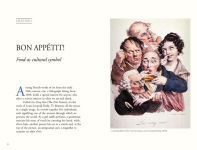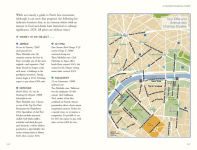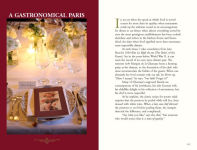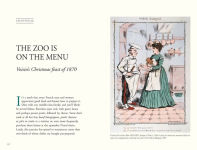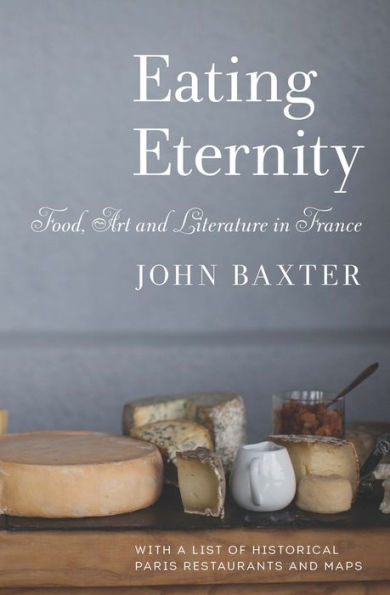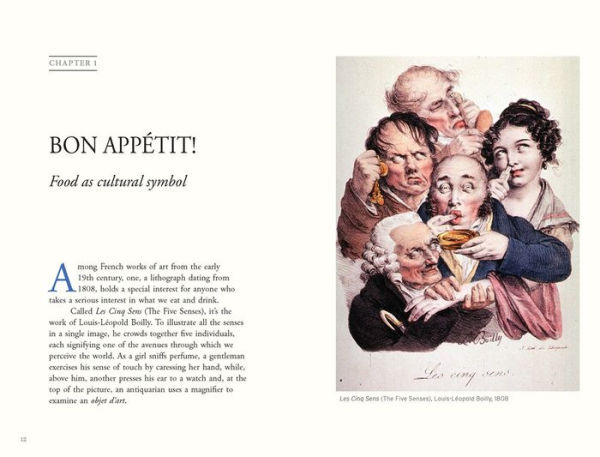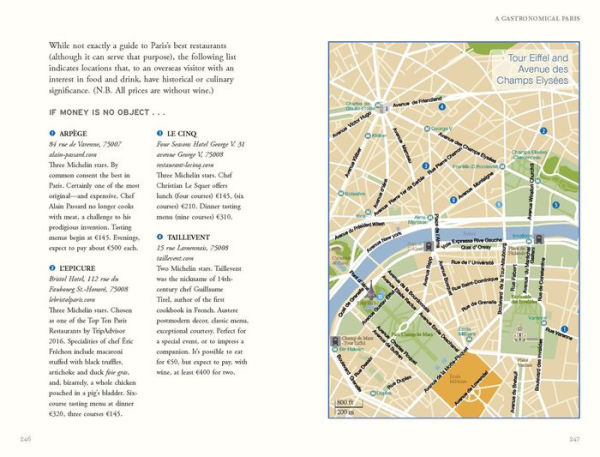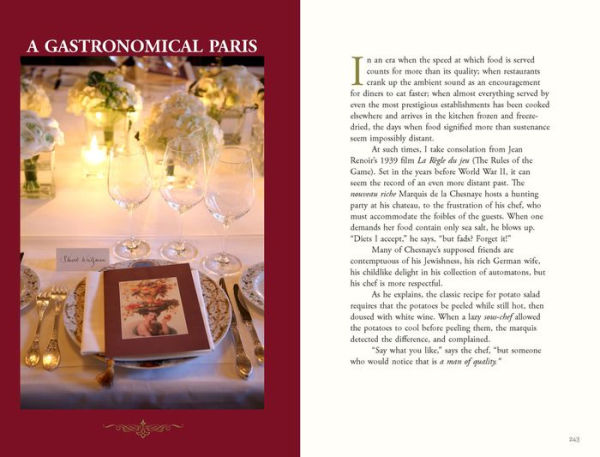

Paperback
-
SHIP THIS ITEMIn stock. Ships in 3-7 days. Typically arrives in 3 weeks.PICK UP IN STORE
Your local store may have stock of this item.
Available within 2 business hours
Related collections and offers
Overview

Product Details
| ISBN-13: | 9781940842165 |
|---|---|
| Publisher: | Museyon |
| Publication date: | 08/01/2017 |
| Pages: | 272 |
| Product dimensions: | 5.20(w) x 7.90(h) x 0.60(d) |
About the Author
Read an Excerpt
CHAPTER 1
BON APPÉTIT!
Food as cultural symbol
Among French works of art from the early 19th century, one, a lithograph dating from 1808, holds a special interest for anyone who takes a serious interest in what we eat and drink.
Called Les Cinq Sens (The Five Senses), it's the work of Louis-Léopold Boilly. To illustrate all the senses in a single image, he crowds together five individuals, each signifying one of the avenues through which we perceive the world. As a girl sniffs perfume, a gentleman exercises his sense of touch by caressing her hand, while, above him, another presses his ear to a watch and, at the top of the picture, an antiquarian uses a magnifier to examine an objet d'art.
Absorbed in their private sensations, none of the four notices the fifth. Eyes wide in appreciation, he holds a plate in one hand while licking the fingers of the other. Clearly, something he's just eaten has ravished his sense of taste.
By placing a contented eater at the center of his composition, Boilly leaves us in no doubt with which of the senses his sympathies lie. Much as one would expect an artist to place greater value on the eyes, he naturally, as a Frenchman, assigned a privileged role to the palate.
In 1825, Jean Anthelme Brillat-Savarin, France's premier philosopher of cuisine, wrote in The Physiology of Taste: "The destiny of nations depends on how they feed themselves." To the generation that followed the fall of Napoleon in 1815, sweeping statements of this kind were not uncommon as its members searched for a new belief to motivate the continuing progress of Europe toward modernity. That food would play a part in this quest, and an important one, was a novel concept for most countries. Not so, however, for France.
For centuries, French culture was segregated into three tiers état or estates: the peasants and middle class or bourgeoisie, who made up 80 percent of the population, the clergé or Catholic church and the noblesse or nobility. (In 1787, British politicians recognized a so-called "Fourth Estate," the press).
Each estate signified its status by what it ate. The aristocracy consumed only what was noble; not of the earth. In their eyes, most vegetables, but particularly potatoes and turnips, were fit only for animals. They also ate no fruit that had touched the ground, since it was believed that such contact was poison. While an association with earth tainted the meat of cattle, sheep and pigs, animals that lived in the wild were considered edible. As with a warrior, the courage shown by a hunted and cornered animal also counted in its favor. The wild boar or sanglier, though a species of pig, could be hunted and eaten, since it earned nobility by living free and, when trapped, fighting savagely for survival.
The church, the ruling ritual of which replicated Christ's last meal with his disciples, regarded food as a reminder of our animal natures, to be enjoyed in moderation. Rather than rejoicing in the numerous biblical references to food, from a few baskets of bread and salt fish feeding a multitude to water becoming wine at the marriage feast at Cana, the church required believers to curtail their appetites by fasting for the 40 days of Lent and forgoing meat on Fridays.
Food was of most importance to the third estate, the peasantry, since it regulated life and death. A single failed harvest could induce famine and starvation. "The table epitomises the peasant's very existence," writes one food historian. "It is the locus of all social relations, a metonym of the earth contracted to four legs, and, when it is replete with food, an icon of the fields in which the peasant labours."
Given this history, it was inevitable that the French would excel in the appreciation of food and drink, the methods used to prepare them, the manner in which they are served, even the terms in which we discuss them. From bouquet, bouillon, banquet, canapé, crouton, consommé, carafe, chef, entrée, gourmet and gastronome to hors d'oeuvre, menu, pâté, purée, sauce, sauté and terrine, the vocabulary of cooking and eating is overwhelmingly French.
In 1927, the annual Salon d'Automne (Autumn Art Exhibition) officially recognized cooking as one of the fine arts, next to painting and sculpture. For a week, the best chefs in Paris took turns to prepare meals at the Salon's restaurant. By 2010, this acceptance had been internationally endorsed. In that year, UNESCO, the cultural arm of the United Nations, designated the classic French dinner or repas for 20 or more diners as an element in humanity's "intangible cultural heritage." To share such a meal with family and friends did more than satisfy hunger; it was "a social practice designed to celebrate the most important moments in the lives of individuals and groups."
Had anyone doubted this importance, the French language offered ample evidence. Food references pepper the slang known as la langue verte: the green tongue. The French equivalent of "the cat's out of the bag" is "the carrots are cooked." Someone stupid is a navet — a turnip — or a poire — a pear. Business is only discussed at the end of a meal, "between the pear and the cheese," while to behave boorishly is to "spit in the soup." It's also traditional, if a trifle old-fashioned, to wish one's fellow guests "bon appétit" (good appetite) as they begin a meal.
Wherever one looks in the social history of France, food is an unacknowledged subtext. Aside from those creators of the kitchen itself who, in preparing dishes for the table, do so with one eye on aesthetic appeal, the French also excel among those who paint and draw food, write about food, film and photograph food, even set it to music. Marcel Proust's cycle of 13 novels, known as À la recherche de temps perdu (In Search of Lost Time), hinges on the memory of a taste; that of a fragment of cake dissolved in some lime flower tea. Gérard Depardieu, one of many actors and performers to own vineyards and restaurants, also starred in a film as François Vatel, the chef who, in 1671, killed himself in the belief that the fish for a royal banquet had not arrived.
Gertrude Stein, encouraging Ernest Hemingway to refine his writing style, sent him to study the single-minded way in which Paul Cézanne painted apples. For the Surrealists of the 1920s and '30s, food was a key that unlocked secret spaces in the mind. René Magritte's The Son of Man shows a businessman in a bowler hat whose face is obscured by a shiny green apple. Luis Buñuel's film Le Charme discret de la bourgeoisie (The Discreet Charm of the Bourgeoisie) follows a group of middle-class ladies and gentleman as they drift around France, casually skirting violent death while they search for a place to eat lunch.
In the way that citizens who fail to turn out for the polls are described as "voting with their feet," the French have, occasionally, voted with their stomachs. During the 1995 presidential election, a Parisian restaurant patronized by both candidates, Jacques Chirac and Édouard Balladur, invited its clients to vote for one or the other by ordering their man's favorite dish. A preference for Chirac's hearty country sausage over the prissy Balladur's herrings in oil was reflected in the former's landslide victory.
France not only pioneered the arts of the kitchen but it was the first nation to acknowledge that certain individuals possess a unique ability to understand food. In defining this skill, it added another word to the international lexicon. A connoisseur, from the verb connaître, is someone who knows his subject, and whose opinion is accordingly privileged. The world of food expertise further refines the definition by distinguishing between gourmets, those who have a heightened appreciation of food; gourmands or gluttons, who carry that appreciation to excess; and gastronomes, defined by UNESCO as "individuals who possess deep knowledge of the [culinary] tradition and preserve its memory [and] watch over the living practice of the rites, thus contributing to their oral and/or written transmission, in particular to younger generations."
Among gastronomes, the function of food and drink is not to satisfy hunger but to tantalize, its motivation a desire, often painful in its intensity, to channel an appreciation of the world through an intentionally restricted area of the senses. Gastronomes seldom eat more than a mouthful of any dish or take more than a sip of wine. Under their influence, the best restaurants introduced a menu de dégustation or tasting menu, made up of a dozen or more dishes, but tiny servings of each. By removing hunger from the equation, gastronomes elevated food to the peak of discrimination. If, as the English epicurean Walter Pater suggested, all art aspires to the condition of music, then it must follow that, in France, food tends to the condition of art.
CHAPTER 2
RULES OF THE HUNT
Aristocracy's sport finds its way into art
The bubonic plague or Black Death that killed half the population of Europe between 1346 and 1353 didn't affect animals. Receding, it left vast tracts of woodland teeming with game. First for the kitchen, then for sport, landowners led packs of hounds in pursuit of wild boar, hares and deer. Trained hawks swooped on pheasants, partridge and grouse. Carp and trout were netted from freshwater streams. Chasing and killing animals offered some of the excitement of war, even a little of the danger, with the bonus that, once the hunt ended, the quarry could be turned into food that not only tasted good, but, in the manner it was served, reminded the diners of how it had been acquired. Each meal was one more moment of pleasure snatched from eternity.
To preserve the exclusivity of hunting, poaching on royal preserves was punishable by mutilation or death. Peasants who risked being blinded simply for stalking an animal were bitter that hunters could summon them at all hours to act as beaters. It was even known for noblemen who felt the cold to order serfs to defecate in a heap, then immerse their feet in the steaming pile to warm them.
The aristocracy devoted much time and effort to maintaining a countryside well-populated with creatures to hunt. "Seasons" protected animals and birds while they were mating and rearing their young. Gamekeepers raised pheasant, partridge and grouse in captivity and restocked woodland that had been "hunted out." Such dates as August 12, known in Britain as "the Glorious 12th," marking the opening of the shooting season for grouse, were red-letter days for the gentry; renewals of their license to slaughter.
Originally, all hunting was called "venery" and all meat from hunted animals classed as venison, but the definition narrowed as deer became the most popular game and their meat correspondingly valued. As "venison" came to mean only deer meat, the French coined a new word, gibier, to define any creature that lived free in water or the open air, and could therefore be honorably hunted.
But food was only a by-product of the hunt. The primary motive was sport, and the prey, in particular foxes, wolves or bears, often chosen for cunning and speed rather than culinary possibilities. As Oscar Wilde scoffed at fox hunting, it was a case of "the unspeakable in pursuit of the uneatable." How one behaved during the hunt also counted for more than a successful kill. Etiquette required that the gentleman hunter not show excessive zeal or expertise, for example, by outrunning the pack or beating the hunt master to the kill. In Isabel Colegate's novel The Shooting Party, a lord taking part in a private shooting competition at a country house party in 1913 is exposed committing the ultimate transgression — target practice.
Hunting provided one of the few occasions in which a nobleman left home. Once gone, he was absent for the entire day, and might even stay out overnight, an opportunity for the women he left behind to explore other diversions. Venery, coined to describe hunting, acquired an additional meaning: the pursuit of sexual satisfaction. Infidelity was so common in the hunting society that a man with an unfaithful wife was signified by showing him with a pair of horns, a reference to the fact that, when a stag lost to another in combat, the winner acquired the loser's mate. The illustration to La Double Chasse (The Double Hunt), an 1839 poem by Pierre-Jean de Béranger, shows a hunt forming in front of a chateau. As the master and his cronies hoot on their horns, eager to be off, the lady of the house sneaks her lover through a window and some jokers slyly hang the antlers of a stag on the master's front door.
Blood was the avatar of every hunt, the symbol of a readiness to kill. The faces of boys on their first hunt were ritually smeared with blood. Medieval stories of the hunt often include the figure of the professional huntsman, a commoner ready to kill at the orders of his master. In the traditional fable of Snow White, the queen sends such a man into the woods with orders to murder her, although, atypically, he relents. Another legend, adapted by Carl Maria von Weber for his 1821 opera Der Freischütz (The Free Shot), transformed the character of Samiel, the Archangel of Death who led the revolt of the angels against God, into the Black Huntsman of the Wolf's Glen, who exchanges the soul of the main character for a rifle that cannot miss.
The most vivid legend associated with hunting is that of the Wilde Jagd or Wild Hunt. Originating in Scandinavia as a hunt led by the god Odin or Woden, it took root in medieval European mythology as a manifestation of the horror that stalked the choked and overgrown woodland of the Dark Ages. Thundering over the treetops and plunging through the forest at impossible speed, the riders of the wild hunt, at the heels of a hunting pack of wolves, were thought to warn of war or plague. People in its path would be trampled, or, in some versions, whirled up in the wake of the phantom riders. In other manifestations of the myth, simply to look upon the hunt was certain death.
Having designated the hunting and eating of game as their monopoly, the gentry emphasized the fact in art. Craftsmen preserved the hide, horns, claws and heads of their kill. Skins and furs became clothing, and antlers were mounted in places of honor. Later, stuffed and mounted trophies of the hunt were supplemented by animalier bronzes: statuettes of game birds, hunting dogs, horses and wild boar.
Paradoxically, the first Europeans to create graphic art from the hunt were men of God. From the abbeys where they had preserved culture during the Dark Ages, monks of the 15th century watched as hunting parties rode out for a day's sport. Turning back to the manuscripts they were painstakingly copying and illustrating, some put aside the pious but dull images of planting and the harvest, and exercised their imagination instead with visions of pheasants exploding from the brush, hawks whirling in the air and brilliantly dressed ladies and gentlemen enjoying a few hours of sunshine and blood.
CHAPTER 3
THE FOOD OF THE POOR
Don't enquire too closely about what goes into the sausage
Paintings reveal much about the eating habits of hunters and of the farmers and servants who made their sport possible. In The Peasant Wedding, painted in 1567, Dutch artist Pieter Brueghel the Elder recorded a typical farmers' feast. There's no meat, fruit or fresh produce on the table, only bread, porridge and pottage: cabbage soup. Everyone drinks beer, brought to the table in earthenware jugs. Instead of plates, flat round loaves of bread called trenchers soaked up any spillage; a robust eater is still called a "trencherman." After the meal, the bread was thrown to the dogs: the origin of "hush puppies," the scraps of fried batter generated by modern barbecues.
For more than a century, historians believed that peasants of the Middle Ages ate almost entirely starches and carbohydrates, but recent research has modified this view. "It isn't necessarily true," writes an archaeologist, "that farmers ate only vile and formless boiled vegetables." From the analysis of middens and garbage dumps, we now know they sometimes consumed meat, eggs and fish — primarily salmon, once so common in the Thames that apprentices complained of having to eat it at every meal. Nevertheless, meat in any quantity, and particularly prime cuts, remained a luxury. The phrase "to eat meat every day" signified wealth, the equivalent of the American "gravy train."
(Continues…)
Excerpted from "Eating Eternity"
by .
Copyright © 2017 John Baxter.
Excerpted by permission of Museyon, Inc..
All rights reserved. No part of this excerpt may be reproduced or reprinted without permission in writing from the publisher.
Excerpts are provided by Dial-A-Book Inc. solely for the personal use of visitors to this web site.
Table of Contents
Introduction 5
Chapter 1 Bon Appétit!: Food as cultural symbol 12
Chapter 2 Rules of the Hunt: Aristocracy's sport finds its way into art 20
Chapter 3 The Food of the Poor: Don't enquire too closely about what goes into the sausage 28
Chapter 4 Feasts at Versailles: Roast peacock, larks' tongues in honey and Louis XIV performs for his guests 34
Chapter 5 Fishing for Compliments: François Vatel's suicide over the disgrace of the missing fish 44
Chapter 6 Tools of the Trade: But first, Louis XVI grabbed the choicest morsels with his fingers 50
Chapter 7 Still Lives: Jean-Baptiste-Siméon Chardin influences Matisse, Cézanne and Picasso 56
Chapter 8 The Dinner at Varennes: Gourmand King Louis XVI becomes prisoner of innkeeper Monsieur Sauce 64
Chapter 9 A Painter in a Pear Tree: Cézanne conquers Paris with an apple 70
Chapter 10 The Humbler Poisons: "Come quickly, I am tasting the stars!" Dom Pérignon 80
Chapter 11 Cheese as a National Symbol: "How can you govern a country that has 246 varieties of cheese?" Charles de Gaulle 88
Chapter 12 The Rise of the Restaurant: Still open: Le Grand Véfour, which served Victor Hugo, Napoleon, Josephine, George Sand, Colette and Jean Cocteau 94
Chapter 13 The Blood of Life: "I live on good soup, not on fine words"-Molière 104
Chapter 14 An Army Runs on its Stomach: Dining with Napoleon Bonaparte 112
Chapter 15 Absinthe, the Green Fairy: "You see things as they really are" Oscar Wilde 122
Chapter 16 The Importance of Bread: Jean-François Millet's The Gleaners 130
Chapter 17 En Plein Air: Lunch in the garden with Claude Monet 136
Chapter 18 Comfort Food: Henri Matisse's codfish paste and devil's potatoes 142
Chapter 18 Setting Meals to Music: Paris café life in the operas of Puccini and Rossini 148
Chapter 20 The Zoo is on the Menu: Voisin's Christmas feast of 1870 156
Chapter 21 On The French Riviera: Renoir, Colette, Picasso, Fitzgerald and Hemingway enjoy the flavors of the Côte d'Azur 168
Chapter 22 Surreal Cannibals: Dalí, Buñuel and cannibal fantasies 178
Chapter 23 Coffee Time: Sartre, de Beauvoir and Camus at the Café de Flore, Modigliani at the Rotonde and Toulouse-Lautrec at the Rat Mort 186
Chapter 24 Shaken But Not Stirred: Add liquor, jazz and Josephine Baker 194
Chapter 25 Melted Camembert and Limp Fried Eggs: Salvador Dalí's The Persistence of Memory 202
Chapter 26 The Food Front: Surviving the German Occupation by rationing, foraging and "Party Surprise" 210
Chapter 27 The Chicken From Hell: New French favorites from India, Russia, China and Vietnam 216
Chapter 28 Stars of the Stove: Carême and Escoffier to Soyer and Child 226
Chapter 29 Food Heaven: The culinary traditions of France 236
A Gastronomical Paris 242
Index 260

